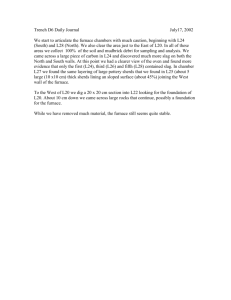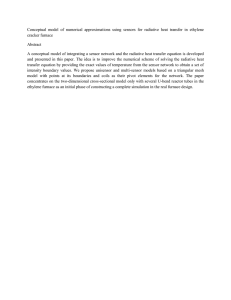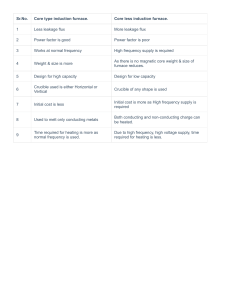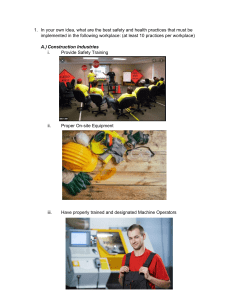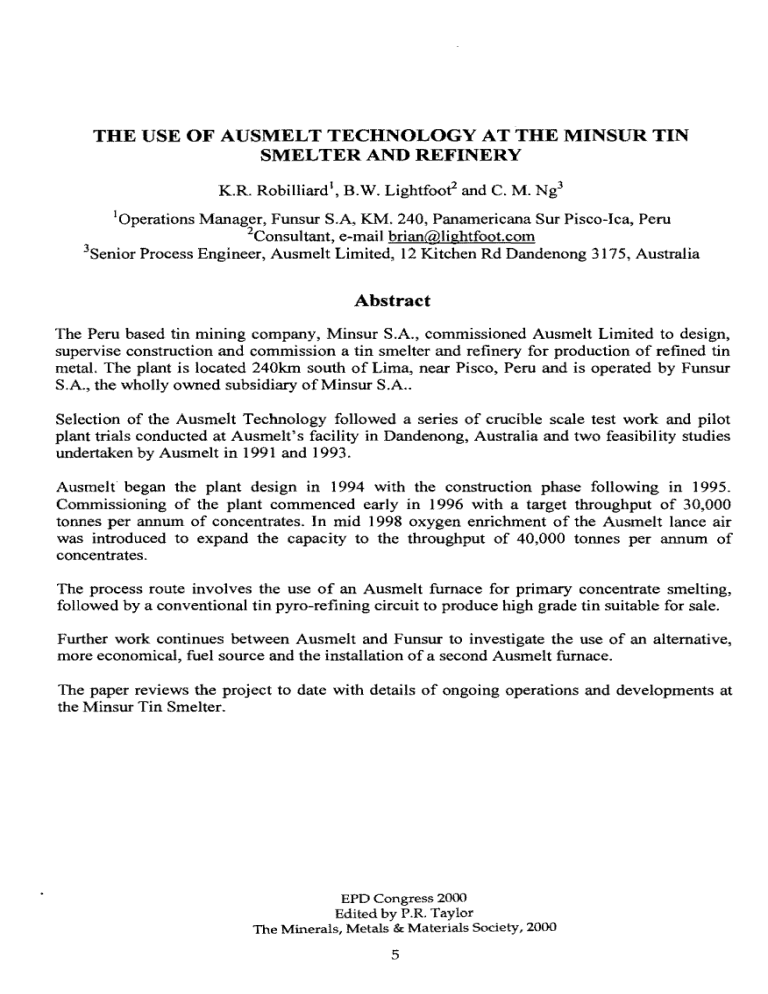
THE USE OF AUSMELT TECHNOLOGY AT THE MINSUR TIN SMELTER AND REFINERY KR. Robilliard l , B.W. Lightfoor and C. M. Ng3 IOperations Manager, Funsur S.A, KM. 240, Panamericana Sur Pisco-Ica, Peru 2Consultant, e-mail brian@lightfoot.com 3Senior Process Engineer, Ausmelt Limited, 12 Kitchen Rd Dandenong 3175, Australia Abstract The Peru based tin mining company, Minsur S.A., commissioned Ausmelt Limited to design, supervise construction and commission a tin smelter and refinery for production of refined tin metal. The plant is located 240km south of Lima, near Pisco, Peru and is operated by Funsur S.A., the wholly owned subsidiary of Minsur S.A.. Selection of the Ausmelt Technology followed a series of crucible scale test work and pilot plant trials conducted at Ausmelt's facility in Dandenong, Australia and two feasibility studies undertaken by Ausmelt in 1991 and 1993. Ausrnelt began the plant design in 1994 with the construction phase following in 1995. Commissioning of the plant commenced early in 1996 with a target throughput of 30,000 tonnes per annum of concentrates. In mid 1998 oxygen enrichment of the Ausmelt lance air was introduced to expand the capacity to the throughput of 40,000 tonnes per annum of concentrates. The process route involves the use of an Ausmelt furnace for primary concentrate smelting, followed by a conventional tin pyro-refining circuit to produce high grade tin suitable for sale. Further work continues between Ausmelt and Funsur to investigate the use of an alternative, more economical, fuel source and the installation of a second Ausmelt furnace. The paper reviews the project to date with details of ongoing operations and developments at the Minsur Tin Smelter. EPD Congress 2000 Edited by P.R. Taylor The Minerals, Metals & Materials Society, 2000 5 Project Background Minsur S.A. is a tin mining company whose operation in the southern sierra region of Peru has been carried out for over thirty years. Minsur is owned by the Brescia Group who has interests in, amongst other things, real estate, banking and hotelry. Minsur has been treating its concentrates internationally in the past and is a respected brand name in the tin industry. The company is now ranked as the largest single tin producer in the world, and its production of 20,000 tonnes per annum of refined tin has ranked Peru in third place behind China and Indonesia in the world scale of production. Ausmelt has been developing the submerged combustion technology, from the original Sirosmelt patent for over 18 years. The technology is applicable to many non-ferrous metals such as copper, lead, zinc, nickel and precious metals, and recent developments have investigated the production of pig iron from ore. Ausmelt Technology has been used previously for tin production, at the Associated Tin Smelters (a division of AMC) plant in Sydney, Australia (late 1970s to early 1980s)' and the HMIB (Billiton) plant in Holland (late 1980s to early 19908). Unfortunately neither plant was able to demonstrate its full potential before they were closed because of tin market crashes. Minsur and Ausmelt have maintained a relationship since the late 1980s and Minsur had been interested since that time to build its own smelter rather than ship concentrates. In 1986 the subsidiary company Funsur S.A. was formed to manage the smelter project. In 1990, Ausmelt carried out a series of laboratory tests, followed by a preliminary feasibility study (1991). Unfortunately, at that time, the political and economic climate in Peru made investment problematic and a decision to proceed with a smelter was not taken. Meanwhile however, development work and collaboration between Minsur and AusmeIt continued. Pilot plant tests at the Ausmelt facility in Melbourne were carried out in 1992 and a revized feasibility study, based on the results was completed in 1993. In the same year, the situation having already improved in Peru in general, Minsur made the decision to proceed with the smelter and the contract, which appointed Ausmelt as project managers, was signed in October. Construction commenced at the Pisco site in February 1995 and in March of 1996, the Minsur Tin Smelter was commissioned. The refinery was commissioned in July 1996, at which time the first refined tin of Minsur brand produced in Peru was then offered for sale. Funsur operates the smelter and refinery. The smelter is located near Pisco, on the Peruvian coast 240 km south of Lima, along the Panamerican Highway. The site location was chosen because of its proximity to the highway, supply of artesianal water and availability of labour. Concentrates are trucked from the mine site (36h by road), and the refined tin trucked the remainder of the way to Lima where it is shipped through the country's major port, Callao. The entire production is exported. The plant uses diesel oil as fuel and had a nameplate capacity of 30,000 dry tonnes of concentrate per year. In May 1998, oxygen enrichment was introduced and capacity was instantly expanded to 40,000 dry tonnes per year. Further investments are being considered to allow further expansions. Conversion from diesel fuel to the cheaper heavy fuel oil is in hand and proceeding well. 6 The Ausmelt Process The Ausmelt process involves a cylindrical furnace which is refractory lined. The lance is located vertically in the geometric centre of the cylinder. The lance may be lowered and raised by use of an overhead crane, or other device. During normal operation the lance tip is submerged in the molten bath. The lifting device may be used to remove the lance completely from the furnace at any time for maintenance purposes. Fuel (either diesel, fine coal, or any gaseous fuel) is introduced at the top of the lance with air (with or without oxygen enrichment). These fluids are mixed and exit as a flame at the lower tip, beneath the bath surface. The combustion of the flame within the bath provides vigorous agitation that allows high heat transfer rates and favours high mass transfer and reaction rates. Feed material is fed through the top of the furnace and allowed to fall into the bath where it is incorporated into the melt. The top of the furnace is an inclined plane that leads to the offgas duct. The size of the furnace will depend on the scale of operation and can range from 0.5m diameter (30-50 mm lance diameter) at pilot plant scale to over 4 m (250-400 mm lance diameter) at full industrial scale. Because of the characteristics of the submerged lance, very high specific feed rates (mass per time, per cubic dimension) can be achieved, which allows for installation of compact plants. In comparison with conventional technology (e.g. reverberatory furnaces) the Ausmelt Technology can achieve a multi-staged operation in a single furnace, which would otherwise require several conventional units, each with their attendant operating and inventory costs (1). Tin Concentrate Process The tin concentrate smelting process that has been developed by Ausmelt (2) is essentially a two-stage process. In the first smelting stage, concentrates, fluxes, coal (reductant) and revert material are fed from weighfeeders through a series of transport devices and the mixed feed enters the furnace. The feed material is melted into the bath by the activity of the lance. During the smelting stage, the process is controlled principally by the tin content in the slag (by adjusting the proportion of coal fed in the charge). Periodically, crude metal is tapped from the base taphole in the furnace while the slag is allowed to accumulate in the furnace. Once the furnace has reached its slag capacity, having fed a batch of concentrates, the reduction stage is commenced. In this stage concentrate, flux and revert material feed is stopped but coal feed is continued. Metal produced during this stage may be tapped from the furnace during the first part of this stage while it is still low in iron. The slag is then reduced to discardable levels of tin. The discard slag is then partially tapped from the furnace while a proportion of the discard slag and all of the final metal is allowed to remain in the furnace. With a shallow slag heel remaining in the furnace a subsequent batch of concentrates is commenced. This allows the high levels of iron in the final metal to be immediately incorporated in the next smelting cycle and thus avoids the inventory of hard head that is so costly to the older smelting technologies. 7 Ancillary plant essential to the furnace process is: Feed Handling: • • • • • Weighfeeders for each material to be fed to the furnace (7 Wlits) Reversible collector transfer belt Feed mixer (pugmill) Main feeder belt (inclined, elevating) Drag link conveyor for direct entry offeed to the furnace Gas Handling: • • • • • • Refractory-lined offtake Evaporative gas cooler Ducting Baghouse filter Induced draught fans Stack Furnace System: • • • • Furnace cooling water system Lance handling system Control system Standby burner In addition, the plant was constructed with a pyro-based refinery to treat the entire furnace production. Additional plant involve chemical laboratory (XRF and Optical Emission Spectrometry), storage facilities for concentrates and other raw materials, service areas for supply of air, fuel and treatment of water, a slag granulation pit, fume and dross handling facilities, offices and ablutions. Commissioning Commissioning of the smelter took place over several stages and the nameplate capacity of 30,000 dry tonnes of concentrates was achieved after 2 years of operation. The initial stage of operation was characterized by non-optimized operating conditions and poor control of bath reduction potential. As a result, tin fuming rates were excessive and this resulted in Wlsatisfactory metal production. The problem was fOWld to be with the selection of the lance nozzles for oil, which when replaced with an alternate design, which produced the desired results and satisfactory metal recoveries were obtained. Plant Availability Plant availability was determined by problems within the process itself and by mechanical problems. 8 Process Problems Downtime associated with process problems included: • Non-optimized slag viscosity which prolonged slag tapping at the end of a batch, delaying the commencement of the subsequent batch. This was controlled in the first instance by introducing heat-up periods, with lance submerged but without feed, during the batch during the smelting stages and prior to the reduction stages. This procedure became unnecessary when operating with oxygen enrichment and satisfactory slag viscosity was obtained consistently. • Accretions in the gas cooler, which caused downtime for cleaning as is discussed below. • Poor control of bath chemistry that resulted in infrequent foaming conditions. Foam was controlled by addition of lumps of iron dross (refinery by-product) to the bath, via the main feeding system. • Short refractory life, which in the first year gave campaigns of 2,000 and 7,000 tonnes of concentrates respectively, and in the second year necessitated three relining activities. • Baghouse filter failure as is discussed below. Operational Improvements Approximately one year after commissioning a number of changes to the operation took place that allowed a significant leap in production and by August 1997, the furnace smelted 2,500 tonnes (wet basis) concentrates for the month, which was within sight of the installed nameplate capacity. This was increased to 3,000 tonnes (wet basis) in March 1998. Changes in both the operation and maintenance of the furnace contributed to this improvement. On the operational side five parameters were studied with the view to optimizing production: • • • • • Change in coal type, from a sub-bituminous coal to an anthracitic coal, which allowed a dramatic reduction in coal addition rates and furnace off gas rates Optimized air-to-fuel ratio in the lance flame (lance stoichiometry) Maximized fuel atomizing air pressure Adjustment of afterburn air flowrates Optimized oil nozzle types (three types having been tested) This eventually allowed the operation to take place with instantaneous feedrates well in excess of those originally designed. Nevertheless overall plant availability still has potential for improvement. Mechanical Problems Downtime associated with mechanical problems included: • Consistent failure of the drag link conveyor feed unit (between the main belt conveyor and furnace). The unit was rebuilt and eventually duplicated, so that they are now operated on alternate batches. This not only allows availability of one unit for routine maintenance, but with the unique system of feeding to either the original feed port or to the original inspection port, allows a better distribution of feed, from 9 • • • • • • • batch to batch. Oversize limestone flux was a contributing factor to the poor performance of the drag link conveyor (DLC). The sizing of the limestone was changed and performance improved markedly. Grid power failures occurred at a frequency of three a month on average. A set of onsite generators had been provided for this event, but with every unplanned stoppage, between 30 minutes and several hours could be lost before normal operations could be resumed. Faults occurred in the potentiometer of the lance hoist system (this unit communicates with the control system to regulate lance flows according to its position, to allow automatic startup on lowering, and shutdown, on raising of the lance). This unit was duplicated to reduce downtime. The lance hoist itself was subjected to a hostile environment and suffered frequent breakdowns in the initial stages of commissioning. On some occasions the 20 tonne overhead maintenance crane was used to allow operation to continue while the lance hoist was being repaired. This carried a severe risk since the overhead crane was not connected to the furnace emergency stop system and this practice has been discontinued. Irregular operation of pumps, motors, flowmeters, compressors and electrical transducers all contributed to downtime, but as these problems were identified and their recurrence foreseen, regular maintenance has diminished their contribution to downtime. Errors in the calibration of the weigh feeders gave rise to delays in the operation, to allow corrective measures for either bath chemistry or heat balance. Calibration of the weigh feeders was carried out on a daily basis and this problem was eliminated. Failure of the limit switches on the lance lifting device which resulted in the accidental departure of the lance clamp from the lance jib, which required downtime for repairs. Careful revision of the limit switches and their programmed replacement eliminated this problem. Accumulation of material (splashed slag, spilled feed material) in the water cooling distribution troughs of the furnace which if left unchecked resulted in hotspots and eventual perforation. This was reduced in frequency by following operational procedures to clean all potential traps for such materials on a once per shift basis. Operation The process defined for the Minsur tin smelter was essentially that defined by Ausmelt (2). The process cycle (batch) consists of starting with an initial slag bath, generally a 300-500 mm heel left from a previous batch, or if starting up from a new reline, a bath of recycle slag fed to the furnace and melted by the lance. The following process is that used having reached full nameplate capacity of 40,000 dry tonnes/year with oxygen enriched lance air. Smelting Stage Concentrates, fluxes, coal and recycle materials are then fed to the furnace in the following proportions: 10 8 - 11 tonnes/h 10 - 20% of concentrates rate 5 - 6% of concentrates rate 15-18% of concentrates rate 2 tonnes/h 0.5-1 tonnes/h Concentrates Coal Iron Ore (flux) Limestone (flux) Baghouse dust (Fume) Refinery dross The lance is operated using the following flows; 9,000 -10,000 Nm 3/h 1,100 - 1,200 kglh 1,000 - 1,100 Nm 3/h Lance Air Fuel oil Oxygen The smelting stage is continued until 40 wet tonnes of concentrate (plus other materials, respectively) are added to the furnace, at which time the furnace is considered having reached its volumetric capacity (depth of slag bath approximately 1.2 m). During the smelting stage tin-in-slag is controlled to 15 - 20% by variation in coal addition rates. Dip samples of slag are taken at 30 minute intervals and the results are posted via a Local Area Network within 20 minutes of receipt by the laboratory. Crude tin metal is tapped two or three times during the smelting stage, without any interruption to the process. Reduction Stage Once feeding of a batch of concentrates is complete, the furnace feed is switched to that of coal only (600-1000 kglh) and the reduction process commenced. Tin-in-final slag levels of 0.7 to 1.8% are achieved in two hours of operation. During this stage, lance air flow rates are lowered to 9,000 Nm 3/h and oxygen enrichment reduced. Metal is tapped from the furnace iftin-in-slag is still above 8%. Metal tapped below this level tended to exhibit a high content of iron and it is more convenient to allow this metal to remain in the furnace. For this purpose the reduction stage is regarded as consisting of two sub stages - the primary and secondary reduction stages. Approximately 40 to 60 minutes are spent for each stage but apart from the demarcation of when to tap the reduction stage metal, no other features distinguish the sub-stages. Tapping of Slag The final stage of the cycle is the tapping of slag, via the granulation launder. This process takes approximately one hour. During this time, the lance is checked by raising and inspecting the tip, and changed if necessary. The gas cooler lower hatch is opened and a preliminary cleaning is carried out. Next Smelting Stage Slag is tapped to a level of 300 - 500 mm, the lance restarted and a new feed batch is commenced. Each batch is carried out in a 6-7 hour period (135 wet tonnes/day). The metal remaining in the furnace from the final stage of the previous reduction is therefore mixed with fresh metal produced from the next batch. With the relatively less harsh reducing conditions, the iron that was reduced is oxidized back into the slag, thus the quality of the metal from the first tap of the next batch is quite satisfactory. 11 Performance Table 1 gives a summary of the throughput of the operation in terms of tonnes of concentrates smelted and tonnes of crude metal produced, for the 8 refractories' campaigns of operation. The concentrates' average grade was 51 % Sn and acceptable recoveries are achieved if the ratio of crude metal to concentrates meets this criterion. Table I: Operating Performance oftbe Minsur Tin Smelter (Note: Concentrates given as Metric Tonnes Wet Basis) Campaign Start Finish Days Conc (t) T/day Metal A B C D 26/3/96 1317196 25/8/96 22/1197 22/2/97 18/6/97 1617197 7111197 Gil H* F E 11112/97 22/5/98 25112198 10104/99 4/5/98 7112/98 1913/99 30111/99* 109 2268 20.8 757 149 7087 47.5 3935 116 6810 58.6 3957 124 10206 82.3 5530 145 13642 94.4 6908 199 20735 104.3 11775 85 10185 120.5 5340 235* 29560* 133 15692* # Campaign halted prematurely because of hearth failure * Current campaign projected performance. Process Parameters Refractory Wear In the initial stages of the commissIOning, the furnace exhibited experienced excessive refractory wear. As the operation became more consistent and as different refractory types were tested, the furnace campaign life exceeded the design rate of six months, with campaign concentrate consumption in excess of20,000 tonnes of concentrates now being the norm. Nevertheless, there is room for improvement and with continued confidence in refractory type selection, and consistent operation, campaign lives of nine months or more (30,000 tonnes concentrates) are thought to be possible. It was found that the most important aspect that favoured prolonged refractory life was that of consistency of operation, and in particular consistency of temperature. For example, with the commissioning of oxygen enrichment in the lance air, when bath temperature was more constant and high feed rates could be sustained without danger of solidifying the bath, requiring time-consuming periods of heating, refractory life improved dramatically. Lance Cbanges The lance tip is subjected to a considerably hostile environment and typically the lance outer sheath tip experiences erosion from time to time. The operating procedure to splash coat the lance each time it is lowered is important, therefore, to ensure long tip life. Nevertheless, it is incumbent on the operators to carry out a lance change occasionally to allow tip repair by maintenance personneL The Minsur Tin Smelter exhibited on average one tip replacement per 36 hours. Since lance changes require downtime for only 20 minutes, and since then this can be carried out during the "dead" time during the tapping of slag (45 - 60 minutes), then lance tip 12 wear and therefore lance changing did not contribute significantly in any adverse way to the operation. Maintenance personnel repair the lance tip in approximately 30 minutes per lance. Oxygen Enrichment Oxygen enrichment has been used successfully in a number of Ausmelt Technology plants (HMIB, Korea Zinc, Metaleurop). The Minsur project was planned in two phases. The first phase during startup and initial normal operation, involved the use of air only as the lance process gas. This phase had an installed nameplate capacity of 30,000 dry tonnes/year. During the 12 month period up to the introduction of oxygen, the plant had not achieved this rate (25,000 tonnes) but it must be considered that during a large part of the previous 12 months the plant was still in its commissioning period. Nevertheless, during the period before operating with oxygen, the plant did achieve 3,000 tonnes (wet) per month, which, given two shutdown periods per year for refractory maintenance is consistent with the original installed annual capacity. In May 1998, on startup of Campaign F of refractories, oxygen enrichment was also initiated. This allowed an immediate increase of concentrate consumption to 3,500 tonnes/month. With further development of the process and continued reduction in downtime, this was gradually increased and 4,000 tonnes/month was achieved within a further 12 months. The plant should achieve its target of 40,000 tonnes (dry) in the calendar year 1999. In the Minsur Ausmelt furnace, oxygen is mixed with air to an enrichment rate of up to 30%. This mixing is carried out in the main lance air ducting immediately prior to the flexible hoses that are attached to the lance jib. The use of oxygen created benefits to the operation of the furnace in a number of ways: • • • • The increase in throughput, which has already been discussed. Faster reduction stage rates due to increased fluidity of the bath. Lower tin-in-slag levels for discard. Prolonged (indeed doubled) refractory life. In addition, there have been several disadvantages with use of oxygen: • • • The problems experienced with the baghouse were initially exacerbated (see below). It was since learned that with better control of startup and shutdown of the oxygen flow and limits to the amount of oxygen enrichment (to 30%), the desired throughput rates could be achieved without excessive baghouse damage. Lance tip wear accelerated slightly, in that while the norm for lance tip life before oxygen was measured in multiple days (and in several cases, a week or more), lance tip life was reduced to an average 24 to 48 hours after the introduction of oxygen. Nevertheless, this was not an important issue, as has been discussed. Increased deportment of impurities in the crude metal as a result of the more complete reduction stage. Although this created problems for the culture of the refinery, it was soon overcome with adjustment of refinery practice. 13 Final Discard Slag The final discard slag consisted of the average composition shown in Table II: Table II: Discard Slag Composition The average tin level includes an overall range of 0.68% to 2.3%. Iron in slag was maintained in the range 19 21 % to ensure adequate fluidity during the reduction and tapping stages. Over-reduction of slag to levels below 0.5% Sn resulted in reduction of iron to 17 - 18% which not only provided problems in the slag tapping stage, but also increased the level of Fe to metal. The bleed of Fe from this system should principally take place via the discard slag phase. Silica was present in the concentrates and iron ore and limestone were added to ensure adequate fluidity, as according to the ternary system FeO-Si02-CaO (3). Limestone was added to ensure sufficient CaO levels and this had two purposes. One was to ensure slag fluidity as has been discussed, and the other was to ensure minimal losses of tin in slag(4) but without affecting the heat balance during the smelting stage with excessive additions of limestone. Gas Cooler Dust Collection A major problem with the operation involved the accumulation of dust in the gas cooler and the exit horizontal duct. Initially, it was necessary to shut the furnace down every two or three days, for several hours to carry out this task, making significant contributions to downtime. Two changes were carried out to improve the situation. • • Operation of the gas cooler in a dry condition, which involved the optimized operation of the pressure difference between atomizing air and water in the spray lances as well as frequent checking of the condition of the spray lance water-cooled jackets. The gas cooler was installed with five spray lances and a technique was adopted that one of the lances could be checked at a time without disruption to the operation. Operation of the gas cooler with a dry base minimized the accumulation of dust in its base and in the horizontal duct. Improved access in the area. This involved the installation of a balloon-type flue with totally opening lower hatches in the short horizontal section, and the installation of inspection hatches in the gas cooler itself to allow rapid cleaning of accreted dust. These two measures were instrumental in restricting the frequency of shutdown for cleaning the gas cooler to once every two weeks. The material collected from the gas cooler was mixed with dust from the baghouse and recycled to the furnace as a single stream. Fume Recycle Fume (baghouse dust) is collected from the baghouse hoppers, pelletized and recycled to the furnace with concentrates feed, coal, fluxes and other revert materials, during the smelting 14 stage. Fume make was approximately 20% of tin fed to the fumace, and this remained as a permanent recycle stream. Improvements to fume handling are being considered. Dross Recycle Iron dross, from crude metal pot skimmings, and as refinery by-products is sieved or crushed and fed to the furnace with concentrates and other feed materials during the smelting stage. The furnace accepts this recycle material readily and sub batches of 5 10 tonnes are fed with each batch of concentrates. This feed rate reflects recycle of both present arisings and attrition of accumulated stock from early operation. Indeed the feeding of dross exhibits a number of advantages to the operation. Dross by nature of its metallic structure is an excellent slag reductant. Furthermore the slag requires a flux of iron and this flux may be partially provided by the iron from the dross. Also dross was found to be an excellent destabiliser of foam. Traditional methods have utilized coal for this task, but since coal tends to float on the surface of the foam, its effect is diminished. Dross on the other hand possesses a high specific gravity and will tend to fall through the foam and destabilise it. Baghouse Operation Operation of the baghouse has been affected by a number of baghouse filter failures and these have impacted on operating costs as well as downtime (or at least lower production rates). This was manifested in two important ways: • • Import of raw combustible material in the baghouse causing widespread damage in ' one cell or more. Selective perforation of some bags, usually in one cell caused by accumulation of sintering fume, Such problems caused considerable downtime, in the first instance to prevent dust losses to the smokestack and prevent widespread pollution, particularly if the baghouse failure was excessive (i,e, the failure of a large number of bags in more than one cell). Even with the less dramatic perforations, one cell would have to be closed for its inspection, resulting in reduced overall feed rates until it was brought back online. Improved baghouse operation has been achieved by incorporating a number of procedural changes, namely: • • • • • Continuous removal of accumulated dust, to prevent it from contacting the lower parts of the bags. If inspection of a cell were required, allowing it to cool and be evacuated for 30 minutes after isolating it before the inspection takes place. Careful startup and shutdown of the oxygen flow during the operation. Careful control of the bath oxygen potential by adjusting lance stoichiometry and coal rates. General maintenance of the equipment to ensure that blow pipes, venturi tubes, cage clamps, upper hatch seals etc" are in good order, Although reduced from earlier peak levels, bag failures remain a feature of the operation because of the nature of the fume material and efforts are being made to seek alternative gas 15 filtering methods. The use of ceramic filters is one option being studied. It is anticipated that other changes to the gas handling system will eliminate these problems. Taphole Failures The metal product is tapped from the furnace by a water-cooled copper block. The block contains a graphite insert, through which the metal (and the oxygen lancing rod) passed. A number of metal taphole failures have taken place during the operation which resulted in one occasion in the complete break out of furnace contents (and two subsequent partial evacuations), which created further downtime, during the initial commissioning and subsequent operation. The problem was caused by over zealous oxygen lancing which eroded the refractory behind the copper block and subsequently the graphite insert. Once the molten tin came into contact with the copper block, rapid erosion took place and the copper block would be dissolved almost entirely within minutes, allowing partial or total uncontrollable evacuation of the furnace contents through the unrestricted orifice. Apart from the danger to personnel from such a breakout, there was an added danger of explosion when the molten tin contacted the water of the cooling jacket. The problem was improved with a number of measures: • • Frequent inspection of the zone with planned maintenance shutdowns to replace the refractory brick behind the copper block. The copper block was inspected and replaced if necessary. This took place every two weeks, at which time other maintenance issues and gas cooler cleaning activity could be undertaken. Use of a larger graphite insert. Use of compressed air instead of water for block cooling, to minimise risk to personnel. Controlling tapping oxygen pressure to 5 bar. • Restricting the number of times that crude tin was tapped per batch to two or three. • • These measures reduced the frequency of taphole failure to approximately one every two years. The slag taphole copper block (located in another area of the furnace) does not experience such problems. Plant Capacity Although the plant has reached its expanded nameplate capacity it is thought that further expansion is possible with some investment. A second Ausmelt furnace has been installed and will be commissioned at the end of the next refractory campaign. This will allow the original furnace to be repaired and re-bricked in a longer time frame without disruption to the operation. The gas handling facilities are operating at their capacity however it is thought that the furnace still can accommodate further expansion, with increases in oxygen enrichment (which in turn is restricted by the gas handling facilities). It is planned to revise the whole of the gas handling system (ducting, filtration system and main fans) and to justify any investment in that area with an increase in production. Alternative Fuel The Ausmelt process is able to use many types of fuel, as has been previously discussed. The Minsur Tin Smelter is in the process of pioneering the application of bunker C fuel in its 16 operation, with a view to reduce operating costs. At the time of writing the results are pending but look promising. The use of other alternative fuels such as natural gas will be considered in the future if the Peruvian natural gas field at Camisea is exploited. Refinery Operation It is beyond the scope of this paper to give a detailed account of the refinery operation. It may be mentioned however that the crude metal, containing quantities of iron, copper, arsenic, antimony, lead and bismuth is handled in the refinery without problems. The major impurities are fire-refined in 50 tonne kettles, while the lead and bismuth are removed by crystallization (technology supplied by Yunnan Tin Corporation of China). The final refined tin quality is 99.95% minimum. Costs The operating cost of the Ausmelt furnace is less than US$400/tonne of concentrate. The breakdown is as follows: • • • • • Labour 17% Consumable Materials 36% Maintenance 21 % General Costs 5% Depreciation 20.7% No cost allowance has been given for the receipt of concentrates, which in the current system is a cost assumed by the mine Conclusions The operation of the Minsur Tin Smelter has demonstrated that the Ausmelt process is a viable technology for smelting of tin concentrates. The furnace produces a high grade crude tin metal with acceptable dross fall. Iron dross that is generated by the refinery is readily consumed by the Ausmelt furnace as recycled materials. The operation involves several stages in the one furnace. Low tin in slag levels can be achieved, allowing minimal losses of recovery. The costs of operating the Ausmelt furnace are competitive with those of other processes. A number of areas however are still under consideration for improvement. These include improved operation of the baghouse and extended refractory life. Expansion of the plant could take place with minimal investment (expansion of ancillary equipment) since the capacity of the furnace itself has yet to be reached. . 17 Acknowledgement The authors wish to acknowledge the kind permission given by the Brescia Group to publish this paper. Acknowledgement is also given to the shareholders of Minsur for their patience during the difficult commissioning period, when costs were assumed without receiving due income from production in those early months. The authors also recognise the efforts made by the Peruvian metallurgists, engineers, shift foreman, leading assistants, the labour force of Funsur together with Ausmelt personnel without whose contribution the plant would never have reached the current performance. References I. lM. Floyd et aI., "Large Scale Development of Submerged Lancing Tin Processes at Associated Tin Smelters" (Paper presented at the AusIMM Melbourne Branch Symposium on Extractive Metallurgy, November 1984), p25. 2. G.P. Swayn, K.R. Robilliard, P.J. King, "Recent Developments in Tin Smelting with Reference to Ausmelt's Sirosmelt Technology", (Paper presented at the Metal Bulletin Conference, Phuket, Thailand, 1992). 3. E.M. Levin et al:, Phase Diagrams for Ceramists (The American Ceramic Society, 1964), p586 4. P.A. Wright, Extractive Metallurgy of Tin (Elsevier Scientific Publishing Company, 1982). 18
